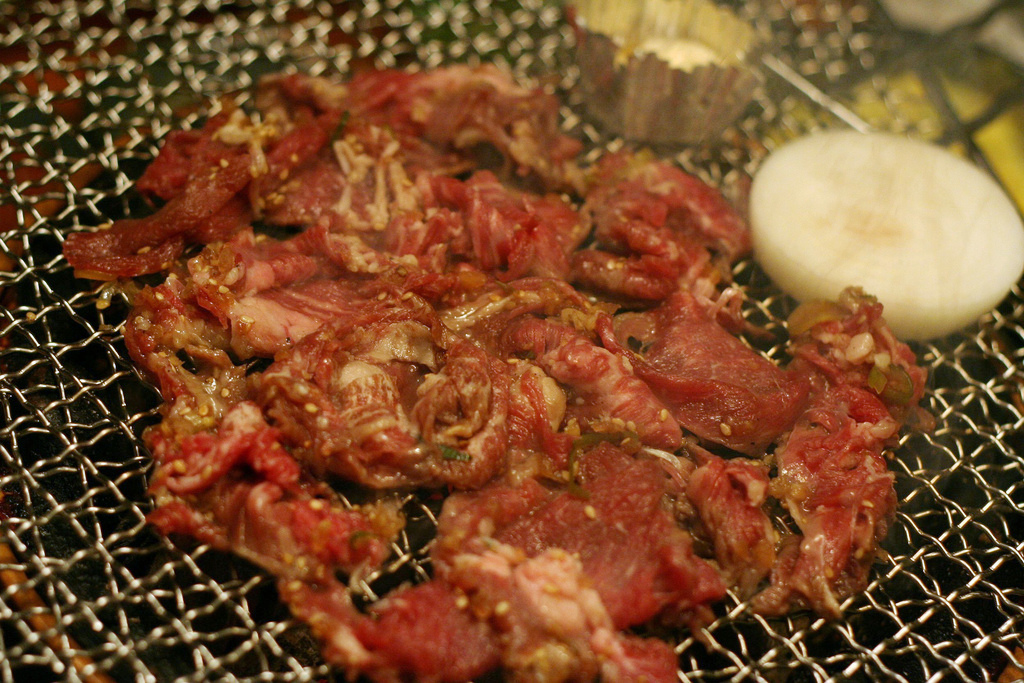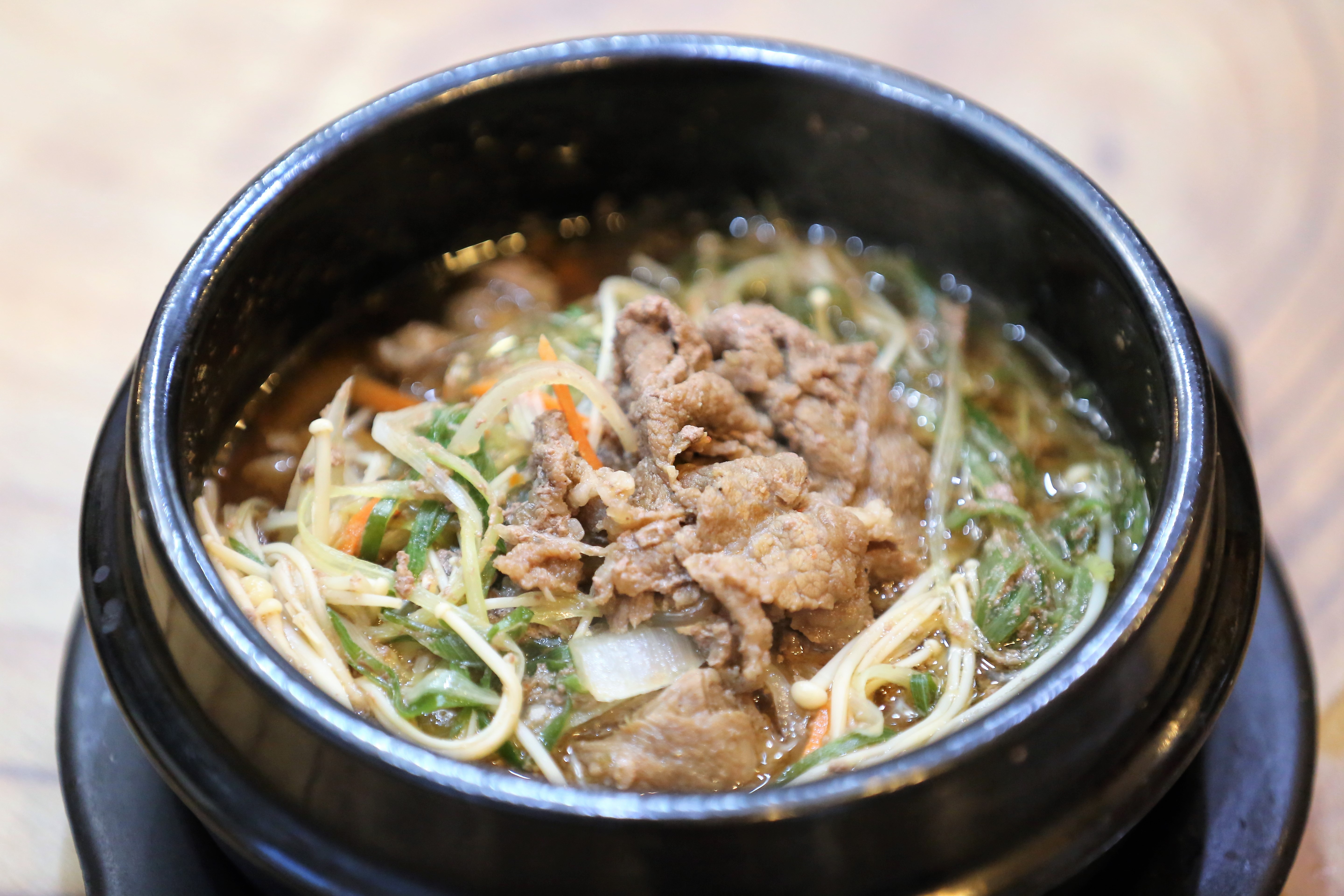Bulgogi on:
[Wikipedia]
[Google]
[Amazon]
Bulgogi ( , , ; , ) is a '' gui'' (Korean-style grilled or roasted dish) made of thin, marinated slices of meat, most commonly
at Encyclopedia of Korean Culture It was called '' neobiani'' (), meaning "thinly spread" meat,Bulgogi
at



 Bulgogi is made from thin slices of sirloin or other prime
Bulgogi is made from thin slices of sirloin or other prime
, Hanwoo Board In many Korean barbecue restaurants, customers are seated at a table that will have a grill installed in the middle. Raw and marinated bulgogi is one of many popular types that customers can order and cook themselves right on the table. It is common for each person to pick at the meat directly from the grill or serve each other when eating. Bulgogi is eaten any time of the year; however, it is common for people in Korea to enjoy grilling the marinated meat on special occasions or in social settings.
Upgrade burgers
, Hankook Ilbo, 2010-06-17. Retrieved 2010-06-27.
beef
Beef is the culinary name for meat from cattle (''Bos taurus''). Beef can be prepared in various ways; Cut of beef, cuts are often used for steak, which can be cooked to varying degrees of doneness, while trimmings are often Ground beef, grou ...
, grilled on a barbecue or on a stove-top griddle. It is also often stir-fried in a pan in home cooking. Sirloin and rib eye are frequently used cuts of beef for the dish. Bulgogi is a very popular dish in South Korea, where it can be found anywhere from upscale restaurants to local supermarkets as pan-ready kits.
Etymology
came from the Korean word ''bulgogi'' (), consisting of ''bul'' ("fire") and ''gogi'' ("meat"). The compound word is derived from the Pyongan dialect, as the dish itself is a delicacy of Pyongan Province, North Korea. The dish became popular in Seoul and other parts of South Korea, introduced by refugees from Pyongan. It was listed in the 1947 edition of the ''Dictionary of the Korean Language'' as meat grilled directly over a charcoal fire. In the '' Standard Korean Language Dictionary'' published by theNational Institute of Korean Language
The National Institute of Korean Language (NIKL; ) is a language regulator of the Korean language based in Seoul, South Korea. It was created on January 23, 1991, by Presidential Decree No. 13163 (November 14, 1990).
It has previously gone by a ...
, the word is listed as meat, such as beef that is thinly sliced, marinated, and grilled over a fire. The word is also included in English-language dictionaries such as the ''Merriam-Webster Dictionary
''Webster's Dictionary'' is any of the US English language dictionaries edited in the early 19th century by Noah Webster (1758–1843), a US lexicographer, as well as numerous related or unrelated dictionaries that have adopted the Webster's n ...
'' and the ''Oxford Dictionary of English
The ''Oxford Dictionary of English'' (''ODE'') is a single-volume English dictionary published by Oxford University Press, first published in 1998 as ''The New Oxford Dictionary of English'' (''NODE''). The word "New" was dropped from the titl ...
''. Merriam-Webster dated the word's appearance in the American English lexicon in 1961.
History
is believed to have originated during theGoguryeo
Goguryeo (37 BC – 668 AD) (; ; Old Korean: Guryeo) also later known as Goryeo (; ; Middle Korean: 고ᇢ롕〮, ''kwòwlyéy''), was a Korean kingdom which was located on the northern and central parts of the Korea, Korean Peninsula an ...
era (37 BCE–668 CE), when it was originally called '' maekjeok'' (), with the beef being grilled on a skewer
A skewer is a thin metal or wood stick used to hold pieces of food together. The word may sometimes be used as a metonym, to refer to the entire food item served on a skewer, as in "chicken skewers". Skewers are used while grilling or roasting ...
.Bulgogiat Encyclopedia of Korean Culture It was called '' neobiani'' (), meaning "thinly spread" meat,Bulgogi
at
Doosan Encyclopedia
''Doosan Encyclopedia'' () is a Korean-language encyclopedia published by Doosan Donga (). The encyclopedia is based on the ''Dong-A Color Encyclopedia'' (), which comprises 30 volumes and began to be published in 1982 by Dong-A Publishing (). ...
during the Joseon
Joseon ( ; ; also romanized as ''Chosun''), officially Great Joseon (), was a dynastic kingdom of Korea that existed for 505 years. It was founded by Taejo of Joseon in July 1392 and replaced by the Korean Empire in October 1897. The kingdom w ...
period and was traditionally prepared especially for the wealthy and the nobility. In the medieval Korean history book ''Dongguksesi'' (), is recorded under the name ''yeomjeok'' (), which means "fire meat." It was grilled barbecue-style on a ''hwaro'' grill on skewers, in pieces approximately 0.5 cm thick. Although it is no longer cooked skewered, this original type of is today called ''bulgogi sanjeok'' ().
Preparation and serving



 Bulgogi is made from thin slices of sirloin or other prime
Bulgogi is made from thin slices of sirloin or other prime cuts of beef
During butchering, beef is first divided into primal cuts, pieces of meat initially separated from the carcass. These are basic sections from which steaks and other subdivisions are cut. Since the animal's legs and neck muscles do the most work ...
. Ribeye is also commonly used due to its tenderness and easily cuttable texture. In addition to beef, chicken and pork bulgogi are also common ingredients used to prepare the dish. Pork belly, or samgyeopsal in Korean, is a popular cut for pork bulgogi. Much like the ribeye, it is tender and fatty which can give the meat a better taste. Before cooking, the meat is marinated to enhance its flavor and tenderness with a mixture of soy sauce
Soy sauce (sometimes called soya sauce in British English) is a liquid condiment of China, Chinese origin, traditionally made from a fermentation (food), fermented paste of soybeans, roasted cereal, grain, brine, and ''Aspergillus oryzae'' or ''A ...
, sugar
Sugar is the generic name for sweet-tasting, soluble carbohydrates, many of which are used in food. Simple sugars, also called monosaccharides, include glucose
Glucose is a sugar with the Chemical formula#Molecular formula, molecul ...
, sesame oil
Sesame oil is an edible vegetable oil derived from sesame seeds. The oil is one of the earliest-known crop-based oils. Worldwide mass modern production is limited due to the inefficient manual harvesting process required to extract the oil. ...
, garlic
Garlic (''Allium sativum'') is a species of bulbous flowering plants in the genus '' Allium''. Its close relatives include the onion, shallot, leek, chives, Welsh onion, and Chinese onion. Garlic is native to central and south Asia, str ...
, ground black pepper
Black pepper (''Piper nigrum'') is a flowering vine in the family Piperaceae, cultivated for its fruit (the peppercorn), which is usually dried and used as a spice and seasoning. The fruit is a drupe (stonefruit) which is about in diameter ...
, and other ingredients such as scallions, ginger, onions, New World peppers, or mushrooms, especially white button mushrooms or ''matsutake
, ''Tricholoma matsutake'', is a species of choice edible mycorrhizal mushroom that grows in Eurasia and North America. It is prized in Japanese cuisine for its distinct odor.
Etymology
The common name and specific epithet, ''matsutake'', i ...
''. In most cases when cooking bulgogi, these are common ingredients. However, the ingredients used to marinate the meat can vary from chef to chef and even from family to family depending on one's preferences and traditions. Pureed pears, pineapple, kiwi, and onions are often used as tenderizers. Sugar or other types of sweeteners such as corn syrup may sometimes also be used to add a sweeter taste. The length of time in which the meat is left to marinate also varies depending on preferences. Generally, bulgogi meat is left to marinate for less than an hour. Sometimes, cellophane noodles
Glass noodles, or fensi (), sometimes called cellophane noodles, are a type of transparent noodle made from starch (such as mung bean starch, potato starch, sweet potato starch, tapioca, or canna (plant), canna starch) and water. They originated ...
are added to the dish, which varies by the region and specific recipe.
The most common way of preparing beef bulgogi produces a dark-looking texture that is well seasoned and flavored. Spicy variations are also common where a spicy paste such as gochujang
''Gochujang'' or red chili paste
* is a savory, sweet, and spicy fermented condiment popular in Korean cooking. It is made from '' gochugaru'' (red chili powder), glutinous rice, '' meju'' (fermented soybean) powder, ''yeotgireum'' (barley m ...
, made from chili powder, rice, fermented soybeans, barley, and salt, is added to the marinade to make the meat spicy. This is most commonly done with the pork variations.
Bulgogi is traditionally grilled
Grilling is a form of cooking that involves heat applied to the surface of food, commonly from above, below or from the side. Grilling usually involves a significant amount of direct, radiant heat, and tends to be used for cooking meat and v ...
, but pan-cooking has become popular as well. Whole cloves of garlic, sliced onions and chopped green peppers are often grilled or fried with the meat. Bulgogi is often served over or with a side of rice and accompanied by various side dishes such as egg soup and kimchi
Kimchi (; ) is a traditional Korean side dish (''banchan'') consisting of salted and fermented vegetables, most often napa cabbage or Korean radish. A wide selection of seasonings are used, including '' gochugaru'' (Korean chili powder), ...
(fermented cabbage). This dish is sometimes served with a side of lettuce
Lettuce (''Lactuca sativa'') is an annual plant of the family Asteraceae mostly grown as a leaf vegetable. The leaves are most often used raw in Green salad, green salads, although lettuce is also seen in other kinds of food, such as sandwiche ...
or other leafy vegetable, which is used to wrap a slice of cooked meat, often along with a dab of ''ssamjang
''Ssamjang'' () is a thick, spicy paste used with food wrapped in a leaf in Korean cuisine. The sauce is made of fermented soy beans ('' doenjang''), red chili paste ('' gochujang''), sesame oil, onion, garlic, green onions, and optionally br ...
'', rice, or other side dishes, and then eaten together.Bulgogi, Hanwoo Board In many Korean barbecue restaurants, customers are seated at a table that will have a grill installed in the middle. Raw and marinated bulgogi is one of many popular types that customers can order and cook themselves right on the table. It is common for each person to pick at the meat directly from the grill or serve each other when eating. Bulgogi is eaten any time of the year; however, it is common for people in Korea to enjoy grilling the marinated meat on special occasions or in social settings.
In popular culture
Bulgogi is served in barbecue restaurants in Korea, and there are bulgogi-flavored fast-foodhamburger
A hamburger (or simply a burger) consists of fillings—usually a patty of ground meat, typically beef—placed inside a sliced bun or bread roll. The patties are often served with cheese, lettuce, tomato, onion, pickles, bacon, or chilis ...
s sold at many South Korean fast-food restaurants. The hamburger patty is marinated in bulgogi sauce and served with lettuce, tomato, onion, and sometimes cheese., Hankook Ilbo, 2010-06-17. Retrieved 2010-06-27.
Variations
* '' Kongnamul-bulgogi'' * '' Osam-bulgogi''See also
* '' Galbi'' * Korean barbecue * Korean royal court cuisine * List of beef dishesReferences
External links
* * * {{Beef Korean beef dishes Korean pork dishes Korean barbecue Joseon cuisine 1st-century BC introductions